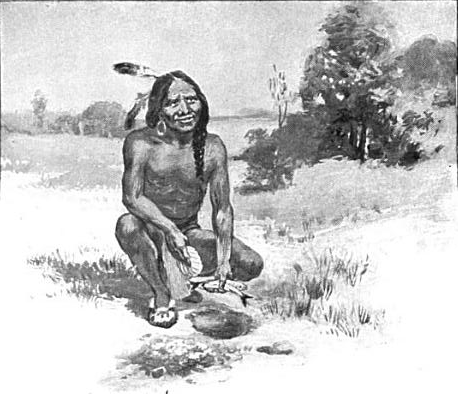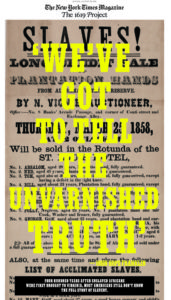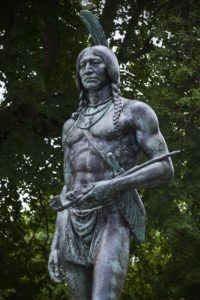Elegy for Tisquantum: The Mayflower at 400
On this month's 400th anniversary of the Mayflower landing at Plymouth, Americans should reconsider the place of Tisquantum in the country's history

A 1911 illustration of Tisquantum
“The seeds of the Mayflower, wafted by the winds of Heaven, or borne in the Eagle’s beak, have been scattered far and wide over the Old World as well as over the New.”
–Rep. Robert Winthrop, Address to the New England Society of New York (1839)
“Let the children of the pilgrims blush, while the son of the forest drops a tear, and groans over the fact of his murdered and departed fathers. He would say to the sons of the pilgrims, (as Job said about his birthday), let the day be dark, the 22nd day of December, 1620; let it be forgotten in your celebration, in your speeches, and by the burying of the Rock that you fathers first put their foot upon.”
–William Apess, Eulogy on King Philip (1836)
The Wampanoag Indian Tisquantum, whom posterity incorrectly remembers as the Squanto of Thanksgiving legend, lived in England before any Englishman had declared Massachusetts his home. Six years separates Tisquantum’s kidnapping and his subsequent sale into slavery, and the arrival of the first so-called Pilgrims at the armpit of Cape Cod peninsula and the ruins of his village Patuxet. In 1620, that Indian settlement was to be rechristened after the sleepy seaside village of the Pilgrim’s journey’s origin – Plymouth. The Tisquantum of reality is not the Squanto of myth. The latter is the eponymous “Noble Savage” of European fantasy, who fully inhabits this howling wilderness with a type of feral wisdom that can be imparted to the Englishmen, who will then be able to survive on America’s unforgiving terrain. “Squanto stayed with them and was their interpreter and was a special instrument sent of God for their good beyond their expectation,” wrote the first governor William Bradford in his Of Plymouth Plantation. “He showed them how to plant corn . . . and guided them to unknown places, and never left them till he died.”
Central to the myth and “Squanto as a Noble Savage” is his impartation of knowledge that would save the suffering Pilgrims, assaulted by freezing New England nor’easters and the bracing, snowy winds of Atlantic squall. More used to parsing their Bibles than tilling fields, the Pilgrims relied on Squanto’s knowledge and instructions, such as burying decomposing fish heads with seeds and corn kernels so the rotting flesh would provide nutrients to the poor soil of New England. Popular historian Nathaniel Philbrick writes in his triumphalist Mayflower: A Story of Courage, Community, and War that “Squanto knew enough of their techniques to give the Pilgrims a crash course in Indian agriculture,” so that the Wampanoag “was on his way to becoming the one person in New England . . . [the Pilgrims] could not do without.” In American myth, Squanto is as the archangel Raphael is to Adam in John Milton’s epic Paradise Lost: an innocent and perfect being who arrives in Eden, though in this version the Indian conveniently takes leave of the story while the Pilgrims stay in Paradise. His life isn’t the stuff of national epic, however. Rather, the narrative of Tisquantum’s bondage and his ultimate emancipation, only to return to a home long since devastated by disease, is actually worthy of any melancholy seventeenth-century picaresque novel.
Pilfered from Massachusetts’ shores by John Smith, Tisquantum was first sold into slavery in Spain, where the English planned to trade human flesh alongside bacalao. He disembarked in Gibraltar and, according to the English slave trader who kidnapped him, Tisquantum was adopted by a group of Catholic friars so that he could be “instructed in the Christian Faith; and so disappointed this unworthy fellow of his hopes of gaine.” Eventually he went to England and would live in the house of a shipbuilder. By the time Tisquantum was able to return to Massachusetts, it was already six years after his seizure, and two years after the Mayflower had disembarked with 102 men, women, and children who would settle that place.
After six years away, Tisquantum discovered that rather than Algonquin land, this was now New England; rather than Patuxet, this was Plymouth; and rather than his fellow Wampanoag, this country was now claimed by those who had abducted him. Now it was a kingdom of bleached skulls and dried bones, what the colonist (and foe of the Puritans) Thomas Morton had described as “a new found Golgotha” as European microbes preceded European bullets. Bernard Bailyn writes in The Barbarous Years that “[d]eath was everywhere. America, for these hopeful utopians, had become a graveyard.” But this so-called “New World” was already a cemetery for its native inhabitants, long before the Pilgrims had discovered America and Tisquantum had already discovered England.
The tale of those hearty hundred Pilgrims, supposedly escaping an Old World where their piety was punished, and so absconding to a providential New World where they could construct an American Jerusalem, is the stuff of Thanksgiving pageants and documentary mythologizing, of elementary school construction-paper belt-buckled hats and cornucopias overflowing with autumnal squash. Such is, despite generations of historical scholarship that have placed the Pilgrims in a more complex and complete understanding – which includes not just denunciatory interpretations, but ones which give rightful consideration to the intellectual rigor of American Puritanism as well – the standard view which still filters out through American education, popular culture, and national self-definition. The nineteenth-century New Hampshire representative Daniel Webster valorized the Pilgrims for their “wise institutions, of liberty, and religion,” such that the “world has seen nothing like this,” and some variation of that maudlin sentiment still holds for many Americans today.
Plymouth Rock Landing On Us
Although this year is the 400th anniversary of the Mayflower’s landing, it seems strangely unremarked upon, perhaps because our present era of pandemic and racial strife is rightly more concerned with current events. The novel coronavirus has led to the cancellation of many planned commemorations, in Plymouth and elsewhere, even while the historical vultures of American history, such as myself, are preparing our editorials both contrary and conventional. There is something anticlimactic with the anniversary this year, coming only about fifteen months after the 400th anniversary of the arrival of enslaved people in Jamestown, Virginia, an event that was recognized by the editors of the “1619 Project” at the New York Times, which popularized several decades of scholarship, a publication that caused great consternation among conservative commentators.

Poster for the 1619 Project
While the “1619 Project” wasn’t without criticism from some scholars, the bulk of opprobrium directed towards editors, such as the Pulitzer Prize winning reporter Nikole Hannah-Jones, came from the precise sort of reactionary pundits and politicians who desperately cling to the mythic storytelling from which Mayflower creches are built. Former Speaker of the House Newt Gingerich accused Hannah-Jones of “brainwashing” and “propaganda,” Senator Tom Cotton claimed the articles were “racially divisive and revisionist,” and in a statement that was only marginally inflected with logorrhea, Donald Trump said on Fox News Sunday, “I just look at – I look at school. I watch, I read, look at the stuff. Now they want to change – 1492, Columbus discovered America. You know, we grew up, you grew up, we all did, that what we learned. Now they want to make it the 1619 project. Where did that come from? What does it represent?” With refreshing (if accidental) honesty, Trump concluded, “I don’t even know.”
Assuming that Trump isn’t familiar with the criticisms leveled by historians Gordon Wood and James McPherson, it seems rather that his distaste is a seamlessly integrated combination of his bigotries and cold political calculation. No doubt that’s the gambit motivating the presidential “1776 Commission” established for the upcoming semiquincentenal of the American Revolution, so as to formulate guidelines for the Orwellian-sounding discipline of “Patriotic Education.” A cynical bit of politicking, since whole swaths of the American public already seem more than surprised to learn that the history of this land is less than pristine.
This has, however, been a season of awakening, where historical figures properly regarded as villains (such as the architects of the Confederacy) are joined by those more widely interpreted as heroes (like the signatories of the Constitution). When we acknowledge the four centuries since the landing of the Mayflower, we must speak of things ugly – genocide and ethnic cleansing, imperialism and colonialism, pandemic and erasure. There are, of course, rosier interpretations as well: that narrative of religious liberty and cultural syncretism which we ritualistically pantomime every November. Maybe that’s why the Mayflower anniversary rings hollow – we’re already exhausted by our ghosts, so that we’ve no desire to engage with some 130 more, whether to exorcize them or not. “For many years, orators, authors of textbooks, historians, politicians, and others have been serving the needs and desires of the present day by creating multiple pasts out of Puritan New England,” writes Abram Van Engen in City on a Hill: A History of American Exceptionalism, and in 2020 what it seems we might most want from Puritan New England is silence.
That would be a mistake, for what I wish we could hear may not be Bradford, or Miles Standish, or Richard Mather, but rather the cipher who lurks at the edge of Plymouth’s woods. No primary accounts of Tisquantum are rendered in his own voice; nothing can be said about his opinions beyond what others imparted to him, or what subsequent mythmakers invented on his behalf. We’ve no sense of Tisquantum’s depths of grief, or the pragmatic calculations that went into his advising the local chief Massasoit, as well as the English. Philbrick writes that though Massasoit had “been swayed by Squanto’s advice,” the Sachem was “loath to place his faith in the former captive, whom he regarded as a conniving cultural mongrel with dubious motives.” Tisquantum’s position was one of ambivalence, perhaps a hybridized man stuck between cultures, but not fully comfortable in either.

A statue of Chief Massasoit. (Photo: Marcio Silva)
A different version of this essay would have me tempted to claim that Tisquantum’s liminal position would qualify him as being the “First American.” That might be a clever claim to make, but an honest reckoning would have to conclude that it’s also an impossible one, or at least a thesis based not on evidence, but rather imagination. It would be to impart our own creative intent only to do what all mythmakers have done – deny Tisquantum his agency. Just because he is not here to define himself shouldn’t give me, or anyone else, the right to define him. Yet there has been a long history of doing just that, constructing phantasmagorias of mythic-history upon the most distant of events, because in controlling the past there is always the possibility of commandeering the future.
For the accumulated detritus of maudlin sentiment and popular history has accrued to the signifier of “Squanto,” so that he is forever enshrined as the uncomplicated man come from the wilderness to share his wisdom with the Pilgrims, only to depart back towards the West and (what was for the colonists wishing to claim this land) a convenient death. He is an archetype of the wise elder living seamlessly with nature, yet as Richard Drinnon makes clear in Facing West: The Metaphysics of Indian-Hating & Empire Building, such sentimentalism is far from neutral. Describing the discourse of the “Noble Savage” or the “natural man,” Drinnon writes, “those deadly subtleties of white hostility that reduced native people to the level of the fauna and flora . . . It reduced all the diverse Native Americans to a single . . . nonwhite group.” Even more crucially, as Drinnon makes clear, that metaphor moves toward an irreducible logic of genocide, for fauna and flora are often intended to be “rooted out.”
In the context of that first Pilgrim winter in America, the agricultural metaphor is particularly ironic, since Tisquantum is forever associated with plant husbandry and the impartation of horticultural knowledge that preserved the English experiment. In this extended metaphor, the English would root in rocky soil, nutriated with rotting cod, while the Wampanoag would ultimately be treated as brush to be cleared away. In a cruel irony, an old legend makes Tisquantum an instrument of his people’s destruction, but one that can’t be blamed on anything Wampanoag. “By colonial standards,” writes Alan Taylor in American Colonies: The Settling of North America, “New England attracted an unusual set of emigrants: the sort of . . . prosperous people who ordinarily stayed at home rather than risk the . . . uncertainties of colonial life.” This over-educated coterie of ministers, professors, and lawyers was ill-equipped not just to Nor’easters and sweltering summers, but to farming more generally. They were, in a phrase, completely and totally out of their element. Tisquantum’s farming lesson, often presented as instruction in the natural wisdom of the Indians, was unknown among the Algonquin — but it was an English practice dating back to the Middle Ages. Undoubtedly, Tisquantum had learned of it while living in England, reflecting Nick Bunker’s point in Making Haste From Babylon: The Mayflower Pilgrims and Their World that Tisquantum had a fruitful “period in London, a city where he had probably spent more time than any of the surviving Pilgrims.”
That the pious subjects of New Jerusalem were too bookish to even recognize the working-class agricultural traditions of their own country speaks to the ironies of that bloody century, though perhaps little more. Crucially, there are unspoken stories, such as that of Tisquantum himself, forever preserved as more symbol than man. Richter reminds us that “stereotyped Indians… become central to the American story, but flesh-and-blood Indian people and the histories they made for themselves could not.” Even if we wished to make Tisquantum more human than metaphor, we don’t have his words that would make that possible.
An anecdote about some fish heads buried in the Massachusetts dirt, which Tisquantum first learned from whatever unnamed English farmer in the distant imperial capital, is a parable with an unclear lesson. I proffer no didacticism here and no intended meaning. My reasons for offering it are estimably humble – to present the strange, surprising, and unpredictable ways in which history manifests itself, and, far more importantly, to emphasize that all narrative is local. No matter what language we use, what models we embrace – whether our history is Whiggish or Marxist, materialist or hagiographical – history is ultimately composed of a seeming infinitude of stories which we’ll simply never know, whether in 1620 or now. The wisdom of understanding how somebody, how a Tisquantum, is able to make their negotiations with the world so that they may live within the midst of grief and terror is something that does not lend itself to simple encapsulation, and yet that seems to be what we demand of our symbols. It is to all our detriment that the man was erased while the legend is all that remains.
Ed Simon is a staff writer for The Millions. His most recent book is Printed in Utopia: The Renaissance’s Radicalism.
***
Published with support from the Henry R. Luce Initiative on Religion in International Affairs.